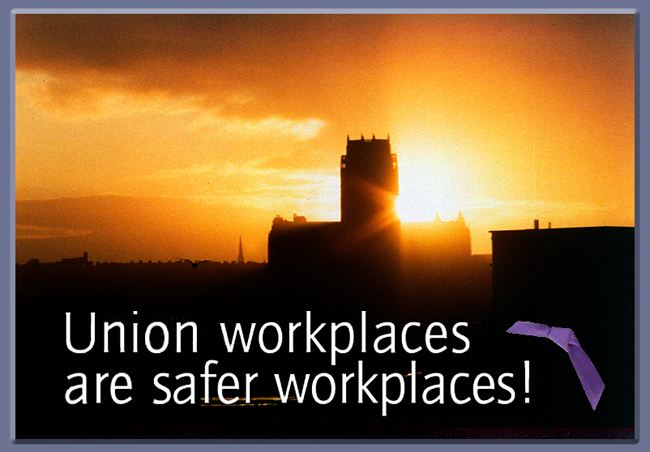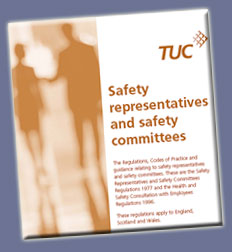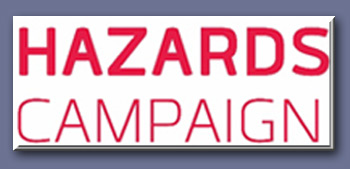-
Partially Used Buildings decaying through lack of maintenance
-
Environmental pollution in builder’s yards, telephone exchanges, industrial estates, and schools including existence of Asbestos
-
USRs forbidden from their statutory right to inspect
-
Employers refusing to act on H&S issues reported by USRs
Many workplaces and methods of working are changing at a dramatic pace, especially those where employers are intending to reduce their building estates and costs due to the current financial climate and the inevitable introduction of artificial intelligence intended to reduce the workforce and automate work processes.
Union Safety Reps are also facing management who have adopted the Government’s attitude that Health and Safety of their workforce is mere ‘Red Tape’ to be ignored, and are pre-empting the repeal of EU based legislation designed to protect employees from harm whilst at work. David Cameron's assertion that accidents are inevitable, paved the way for increases in workplace injuries, work-related suicides and work-related deaths.
 Deregulation is all about removing worker's rights and the employer's responsibility to provide a safe and healthy working environment for their employees.
Deregulation is all about removing worker's rights and the employer's responsibility to provide a safe and healthy working environment for their employees.
With Unions stretched resources and sometimes unable to address health & safety at work to the full extent required, and often caused by Union Safety Reps facilities are being subsumed into that of ordinary union reps, despite their lack of knowledge, expertise, and workplace experience; Trade Unions need to challenge such attacks by employers using the Safety Reps and Safety Committees Regulations which, which provides them with specific statutory rights.
In effect, every time an employer denies USR’s their rights, the employer is breaking the law!
With major concerns being raised in a number of industries and areas of UK businesses, especially where buildings and estates are producing localised environmental pollution including metal, electrical and indeed Asbestos contaminated waste, as a result of decaying structures and reduced usage before being torn down.
The lack of maintaining such buildings in order to cut business cost, lack of adhering to pollution and environment protection laws, and short cutting of safe working procedures; is becoming a national issue across the UK.
 Hazards Campaign’s Janet Newsham told Unionsafety and local USRs that:
Hazards Campaign’s Janet Newsham told Unionsafety and local USRs that:
‘The bottom line is that employers cannot abdicate responsibility for harming workers because buildings are not fit for purpose and they are going to vacate them in the future. They can bring in short term measures to control the risks, but not ignore the harm that is being caused.’
In the North West, TU health & safety committees have raised issues with their respective employers and been met with, in some cases, threats against USRs and union members.
Trade Unions and their safety reps need to use the Safety Reps and Safety Committees Regulations to pressure employers to abide by these statutory rights and ensure full cooperation with addressing issues and working with USRs as per the legislation. In worse case situations where managers are pressurising staff to cut corners on working safely, and going against the businesses own policy of safe methods of work; the HSE or local enforcing agencies may well be needed to be approached to ensure employers abide with safety legislation.
All USRs need to address with their employers, the lack of maintenance and in many cases deliberate running down of workplaces and buildings, by using current health & safety legislation outlined here by Hazards Campaign:
Health and safety at work
Under ‘common law’, all employers have a duty of care which is an obligation to protect their employees. A term is implied into all employment contracts requiring employers to take care of their employees’ health and safety. For example, employers must:
• Provide a safe place of work.
• Provide a safe system of work.
• Provide adequate plant and equipment.
• Recruit competent and safety conscious staff.
Main legislation
 • Health and Safety at Work Act 1974
• Health and Safety at Work Act 1974
o To ensure the health, safety and welfare at work of their employees and refers to ensuring the physical and mental health of workers.
o The Health and Safety at Work Act 1974 (HSWA) covers all workplaces, and says that an employer must do everything reasonably practicable to provide a safe and healthy workplace.
o Under section 2 of HSWA, employers should provide systems of work and a working environment which are, as far as is reasonably practicable, safe and without risk to health.
o Section 4 places a duty on anybody responsible for places of work to ensure that premises themselves as well as plant and machinery in them do not endanger people using them.
• Management of Health and Safety at Work Regulations 1999
Sets out what employers are required to do to manage health and safety under HSWA. This includes identifying, assessing and controlling risks using a control hierarchy approach
• Regulatory Reform (Fire Safety) Order 2005
Under this order the ‘responsible person’ for each premises will be required to carry out a fire risk assessment and take steps to reduce or remover the risk. All organisations must take precautionary measures to control fire risks, provide fire escape routes and training, and carry out fire safety risk assessments; those with five or more employees have additional record keeping responsibilities.
• The Workplace (Health, Safety and Welfare) Regulations 1992 cover, for example:
o Maintaining the workplace, equipment, devices and systems.
o Providing ventilation by ensuring a sufficient quantity of fresh and purified air.
o Maintaining a reasonable temperature, and the provision of thermometers.
o Ensuring suitable, sufficient and natural light so far as is reasonably practicable.
• The Control of Asbestos Regulations (CAWR) 2012
* Managing Asbestos in buildings (reg 4) – whoever has control of a building has a duty to manage the asbestos in their buildings
* Recorded survey
* Suitable risk assessment carried out before any work which may expose employees to asbestos
* Regulation 5 – Identifying the presence of asbestos
• Control of Substances Hazardous to Health Regulations (COSHH) 2002
* Biological hazards include anything biological that can cause harm to humans eg viruses, bacteria and fungi.
Workers can be incidentally exposed to biological hazards such as fungal moulds in damp workplaces or Legionella bacteria due to poorly managed water systems and cooling towers.
• SRSC Regs
 Employers have an absolute duty to permit safety reps to inspect:
Employers have an absolute duty to permit safety reps to inspect:
* every 3 months,
* after a notifiable accident,dangerous occurrence or notifiable disease,
* after a substantial change in working conditions after new information has become available from HSE and inspect relevant documents;
* Investigate potential hazards and dangerous occurrences, examine causes of accidents and investigate complaints by employees;
Safety reps can make representations on specific and general matters to employers; Employers shall consult safety reps in good time on intro of any measure that substantially affects health and safety, the arrangements for appointing or nominating competent person, health and safety information, planning and organisation of health and safety training and the consequences of planning and introduction of new technology.
Suggested Action plan:
1. Draw up a priority list of actions, including:
a. For each of the above legislation ask management who is taking responsibility from your employment for it. There will be joint ownership of some activities and that must be clearly indicated or where another organisation is responsible then this must be also be indicated.
b. If the employer is signed and certified as ISO14001 or ISO45001 compliant then there should be process in place to show how they are fulfilling this – an audit which should be available to inspect and if they aren’t then they can be reported to the relevant authority.
c. Carry out TU Inspections of different areas using a checklist of all relevant issues above
d. Conduct a survey of members on all relevant issues
e. Carry out a body mapping exercise to record harm to employees in different areas
f. Analyse results and prepare a report to management with recommendations and a timescale of action
g. Present report to management in all forums including health and safety committee
h. Present information to members on what has been presented and progress made
2. Ensure progress is being made on all issues raised and escalate internally where employer refuses or frustrates progress
3. If necessary, after raising issues internally, escalate to enforcement authorities if employer is refusing to comply with health and safety legislation
4. Keep an audit trail and portfolio of evidence to present to enforcement authorities
5. Get legal advice on non-compliance/negligence
 Some of the criticisms of the Grenfell inquiry is the lack of ownership of the safety issues and this is a criticism that can be raised in this case where management are failing to control the risks across the estate.
Some of the criticisms of the Grenfell inquiry is the lack of ownership of the safety issues and this is a criticism that can be raised in this case where management are failing to control the risks across the estate.
Hazards Campaign’s Safety Reps meeting recently, there were a number of issues raised around building maintenance in different industrial settings.
The campaign group intend to host a special meeting in the near future to discuss this further. Unionsafety will ensure further details when that is announced.
Source: Janet Newsham / Hazards / unionsafety / CWU USRs